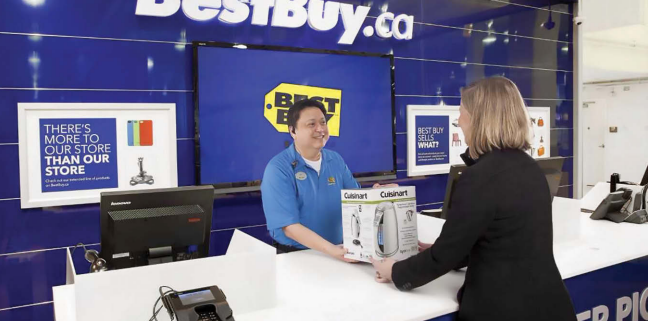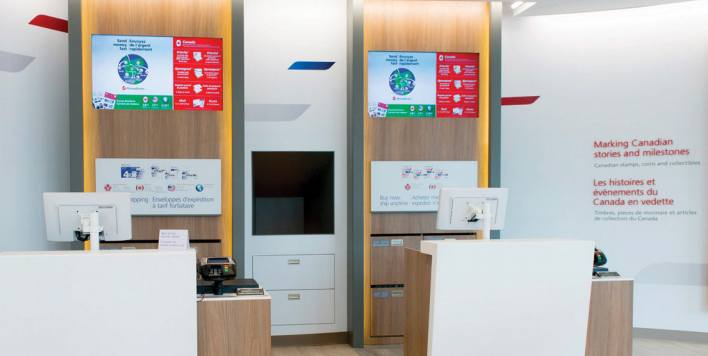Reimagining the last mile: Finding efficiencies and reducing costs in order fulfillment
September 18, 2017
Finding efficiencies and reducing costs in order fulfillment
BY CRAIG PATTERSON
THE ‘last mile’ is the most cost-intensive part of the supply chain for retailers. Be it the final delivery of goods from distribution centre to retail store, or to the consumer’s front door, the rise of omnichannel retail has resulted in increased demand for last-mile resources. Retailers are innovating to make the last mile more efficient, and they’re using a variety of strategies to best serve the consumer.
Retailers doing business in Canada are delivering product to consumers more than ever before, though delivering door-to-door can be expensive—and returns can be complicated. Some retailers are instead choosing the ‘click-and-collect’ model, where shoppers make a purchase online, and pick it up in the store. The future of the last mile will involve innovation and efficiencies, including crowdsourcing and possibly even drone delivery.
Delivering door-to-door
Canada is a vast country in terms of geography, and relatively small in population. As a result, delivering to individual homes can be a challenge. Nevertheless, leading retailers are innovating to bring product to consumers. Best Buy Canada, which received Retail Council of Canada’s Excellence in Retailing Award for Omnichannel in both 2016 as well as 2017, continues to innovate in its endeavours to address the last mile. Philippe Arrata, Senior Vice President and Chief Administrative Officer at Best Buy, discussed how his company is fulfilling orders from its warehouses, as well as stores, with remarkably short delivery times.
Best Buy’s warehouses are in Vancouver and Toronto, where vendors drop off products that will either be distributed to Best Buy’s stores, or kept onsite to be sent to customers when they order online. Best Buy offers free next-day shipping in the greater Vancouver, Toronto and Montreal markets, and for the rest of Canada it’s generally up to two days for a delivery. Given Canada’s vast geography, Best Buy is innovating by also shipping from its stores. The company’s Ship-FromStore program unlocks inventory across the distribution chain, and has improved inventory efficiency by allowing customers to access all inventory regardless of location, not to mention shortening delivery times. Remarkably, 91 per cent of Best Buy’s Ship-From-Store orders are fulfilled within 48 hours.
Best Buy’s Delivery Estimate function on its website leverages geo-location technology and carrier partner data to provide an accurate delivery timeline, as customers browse products and place orders online. Shipping is free for orders over $35, and Arrata notes that Best Buy has managed to reduce shipping times from an average of seven days to just two days on most orders, without charging excess fees or requiring memberships.

Best Buy’s website also features product that is fulfilled directly from the vendor. Launched in January of 2016, Best Buy’s ‘Marketplace’ allows sellers of brands not traditionally associated with Best Buy’s typical consumer electronics assortment to sell to Best Buy’s consumers. These brands are provided the opportunity to showcase on the BestBuy.ca site, which has unmatched traffic and e-commerce capabilities. Brands get the exposure of being on Best Buy’s website, and these products ship directly from the vendor to the consumer.
BEST BUY CANADA’S PHILIPPE ARRATA NOTES THAT BEST BUY HAS MANAGED TO REDUCE SHIPPING TIMES FROM AN AVERAGE OF SEVEN DAYS TO JUST TWO DAYS ON MOST ORDERS, WITHOUT CHARGING EXCESS FEES OR REQUIRING MEMBERSHIPS.
Walmart Canada’s Vice President of E-commerce Operations and Logistics, Michelle Grose, explains that the company owns and operates its own fleet of vehicles and how its efficiencies reduce overall costs. Walmart Canada’s fleet allows it to fully leverage its network of stores to reduce shipping costs through programs like ship-tostore that Walmart’s introducing this year at over 150 locations. Its focus on lowering shipping costs allows it to pass savings on to the consumer with lower prices. Walmart excels in the area of logistics, which makes sense—not only does it have 410 stores in Canada, it also makes provision for delivery directly to consumers’ homes.
Walmart Canada’s home delivery includes free shipping on orders exceeding $50. It’s a “pioneer in the final mile” according to Grose, who described a relatively new phenomenon of crowdsource delivery. Walmart utilizes services such as JoeyCo and Daily Delivery to get product to consumers—it’s “Uber like”, she explained, and could be a trend where non-dedicated resources are able to provide individual deliveries in a timely, and relatively cost-effective way. She also noted that Walmart uses a variety of means to deliver goods to consumers, including traditional carriers such as Canada Post.
Upscale Seattle-based department store chain Nordstrom opened its first Canadian store in the fall of 2014, and will soon have six full-line stores in Canada. Nordstrom spokesperson John Bailey explained that the majority of Nordstrom’s suppliers deliver product to its distribution centre in Toronto, and once received, items are ticketed, placed on hangers, and prepared to be shipped out to one of Nordstrom’s Canadian locations.
While Nordstrom currently lacks a dedicated e-commerce site specifically for Canadian consumers, Nordstrom goes the extra mile with some customer-service focused initiatives. In Toronto and Vancouver, Nordstrom offers free delivery within the respective downtown cores within two hours, and same day delivery within 10 kilometres for a fee of $15. Nordstrom also offers ‘mobile’ retail in Toronto and Vancouver. ‘Nordstrom to You’ offers styling, tailoring and deliveries right to the customer’s door, in an effort to make shopping at Nordstrom as convenient as possible.
Click-and-collect
Another strategy to address the last mile is click-and-collect—that is, consumers order online and come to the store to pick up their purchases. It’s often more cost-effective for the retailer, as it’s the consumer that is taking the time and effort to pick up their order. It’s also a way for retailers to strengthen relationships with clients with some face-to-face interaction.
Best Buy’s Arrata says the company’s clickand-collect system has been highly successful. Shoppers on the company’s e-commerce site may utilize its ‘Reserve and Pick-Up’, where an item can be reserved online with a commitment that it will be ready for pick-up in-store within 20 minutes of placing the reservation (and most times are ready for customer pick-up in only 10 minutes). An email is sent letting the customer know that the item will be held for 24 hours. Customers pay upon pickup, allowing for flexible payment options. “Many consumers tell us that they prefer to pick up items in-store,” says Arrata, noting that about 80 per cent of Canada’s population lives within 25 kilometres of a Best Buy Store.

“THEY’VE [AMAZON] GOT IT [RETURNS] DOWN. CONSUMERS ARE SURPRISED AT HOW EASY THE PROCESS IS.”
KARL DEVEAUX UPS Store
Walmart also recently launched a click-and-collect program at 122 of its 410 Canadian stores, where consumers may order online and for free, pick up their orders in their desired Walmart stores. The number of locations included as part of the program will soon grow, according to Grose. She described how, particularly with fresh food that is perishable, the click-and-collect model works by providing the consumer with a window of time to pick up their items. Shoppers order from Walmart’s website and register for a window of time when they can pick up the goods. Walmart “works backwards to ensure that the timing is right, where the consumer gets the freshest and best quality possible,” Grose says. When the customer arrives at the store, they can pull into a dedicated parking space and call an associate for convenient delivery.

Returns
Karl Deveaux, owner of one of Canada’s busiest UPS Store locations in Edmonton, identifies returns as a critical piece of the retail chain, explaining some of the challenges he’s seen with returns, as well as how some retailers are getting it right in terms of best serving the e-commerce consumer.
“It really depends on the retailer,” said Deveaux. “Some retailers have made the process of returning product simple by providing labels and packaging, while others have not.”
He says Amazon makes up about 80 per cent of the retail packages going through his Edmonton UPS location. “They’ve got it down”, says Deveau, explaining how Amazon supplies customers with pre-paid labels and packaging specifically for returns. “Consumers are surprised at how easy the process is,” he notes, going on to say that Apple has also perfected the process of facilitating returns.
Some retailers make things more difficult for returns, and the consumer may be in for a big surprise when they go to make one. “It becomes complicated and can be costly when a retailer doesn’t make provision for consumer returns,” he says. “If the retailer hasn’t paid for prepaid shipping, the consumer trying to return products can be on the hook for having to pay for it themselves. If the item is fragile, the cost of packaging and shipping the return can sometimes be more than that of the original product purchase.” Deveaux explains that consumers may become dissatisfied with the retailer, not to mention his UPS store, when returns become complicated and time consuming.
Things can be even more complicated when ordering from retailers in the United States.
“There’s often extra time involved when making a return to a retailer in the US, which may even require paperwork where the consumer has to explain the makeup of an item—with a garment, for example, she may have to reveal the percentage makeup of its fabric. And if that’s not done,” Deveau says, “it can be held up in customs with penalties”.
Canada Post’s ‘Drive-thru Parcel Centre’ is addressing returns in a unique way by introducing dressing rooms as a prototype in three of its locations. Each prototype location features a 50-square-foot private fitting room, where customers can try on their apparel purchases as soon as they receive their parcels at the post office. Clothing that does not fit, or is the wrong colour, can be easily returned immediately without ever leaving the post office.
“IT [RETURNS] BECOMES COMPLICATED AND CAN BE COSTLY WHEN A RETAILER DOESN’T MAKE PROVISIONS FOR CONSUMER RETURNS.”
KARL DEVEAUX
UPS Store
What does the future hold in terms of innovating with the last mile? There are many possibilities, ranging from self-driving cars to drone delivery to uber-like services. While drone delivery might not be feasible in some cities, Best Buy’s Philippe Arrata noted that it could be useful in shipping product from a distribution centre to a store. What is clear, is as Canadian retailers continue to compete and look for efficiencies while reducing costs, the last mile will be a critical gap to fill in order to gain competitive advantage and win the Canadian retail wars.


